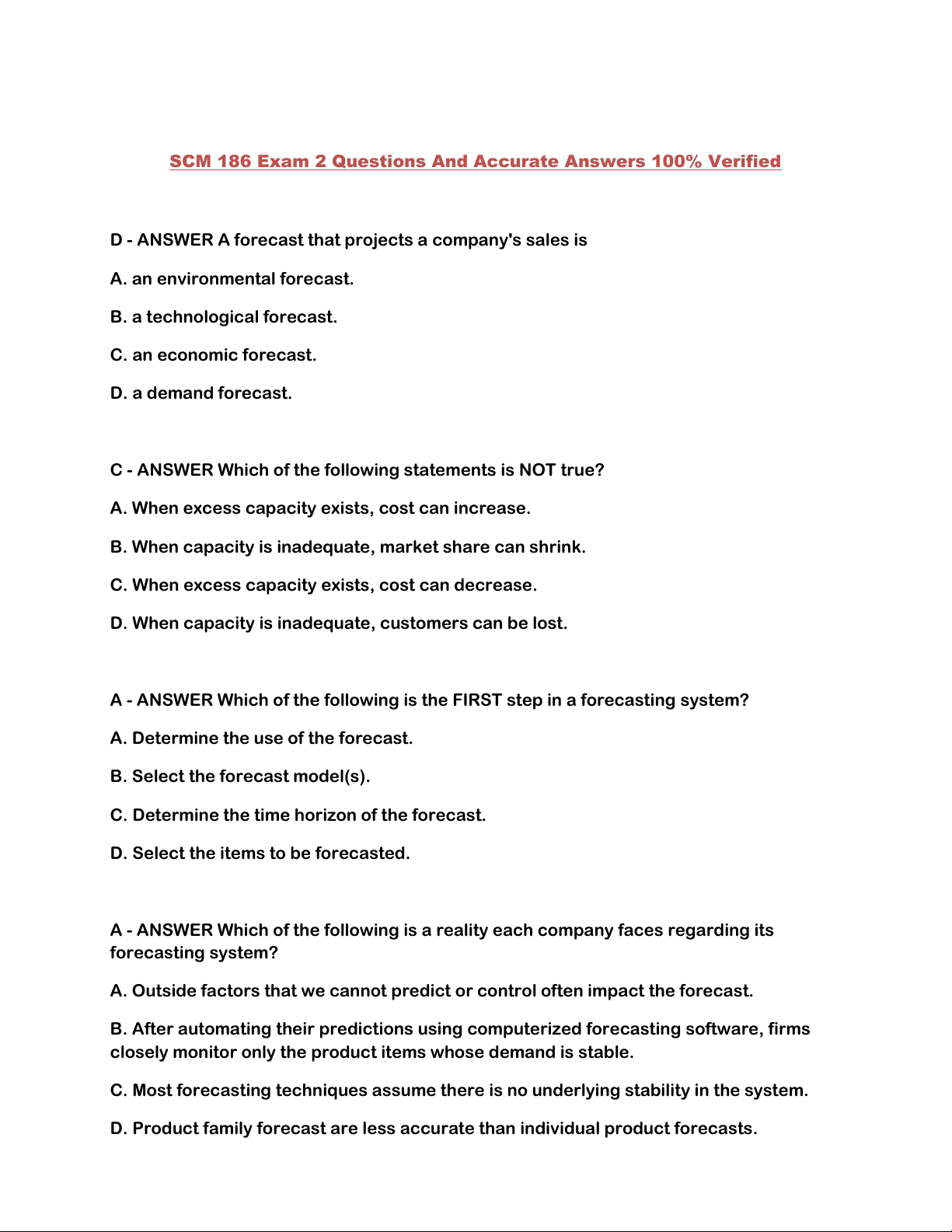
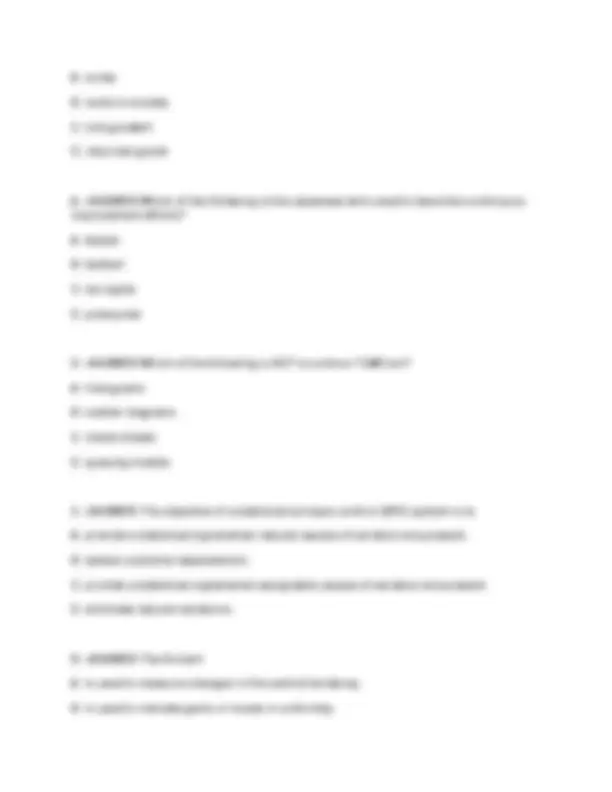
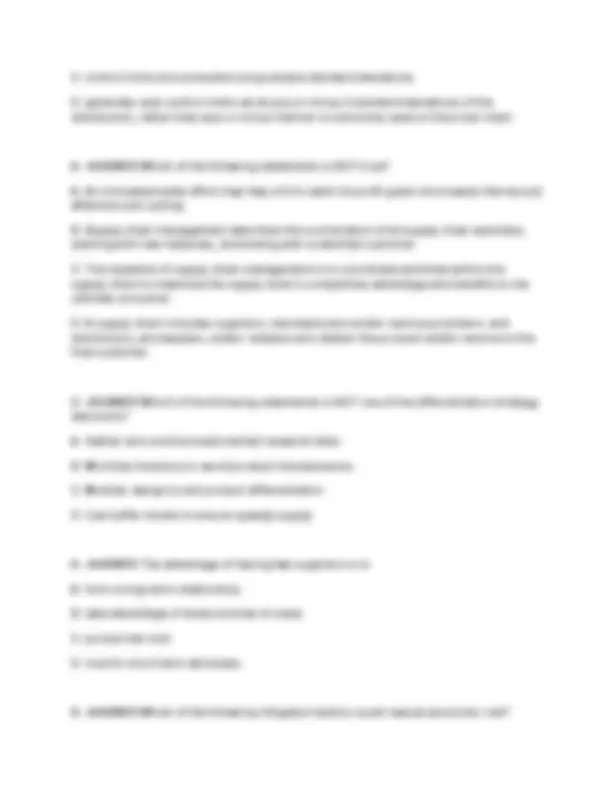
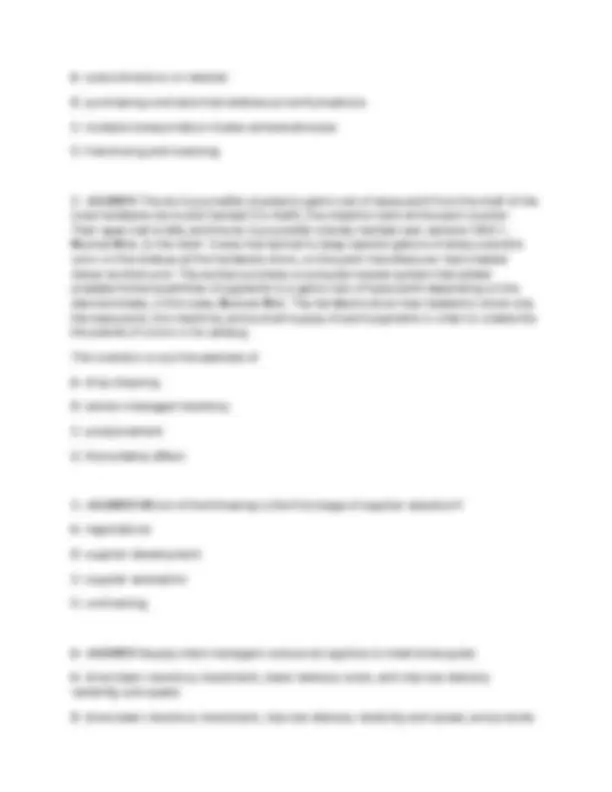
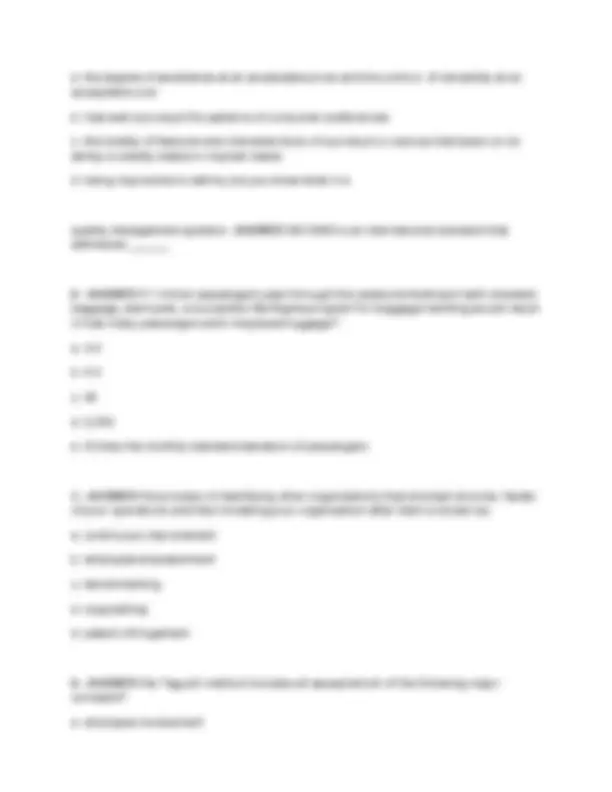
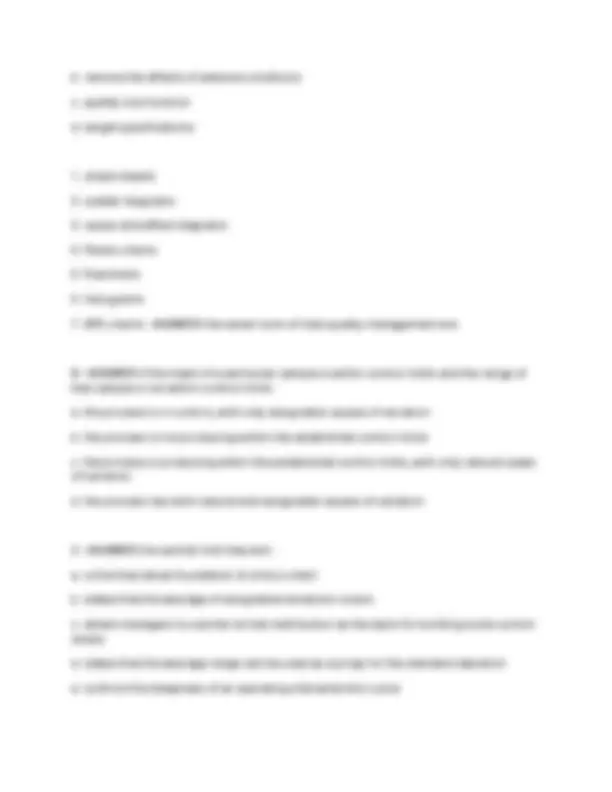
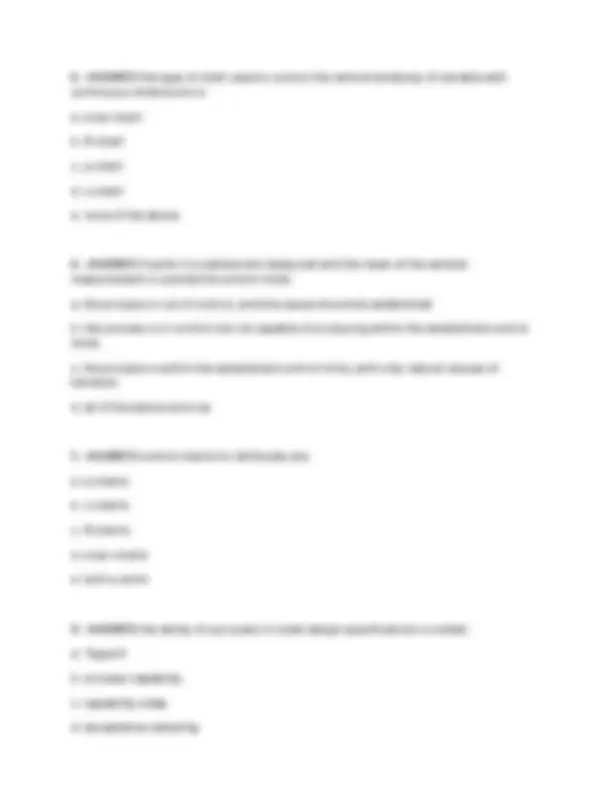
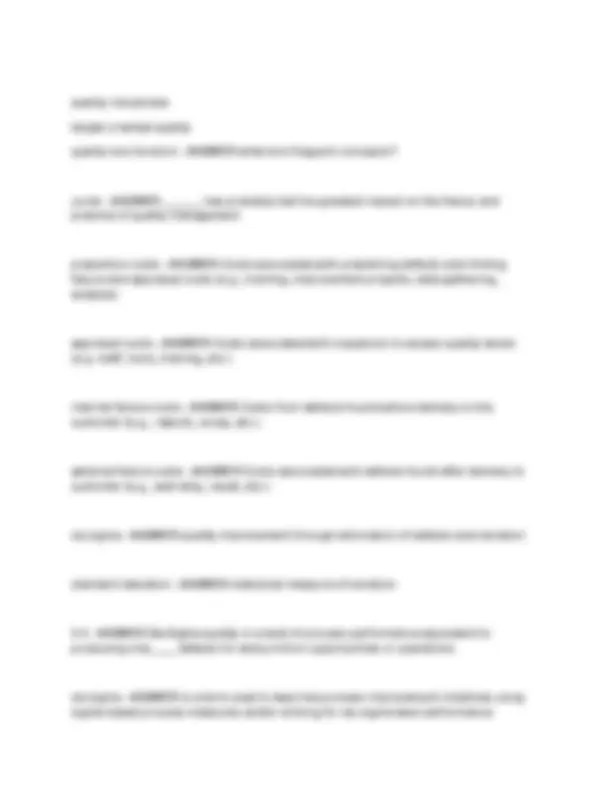
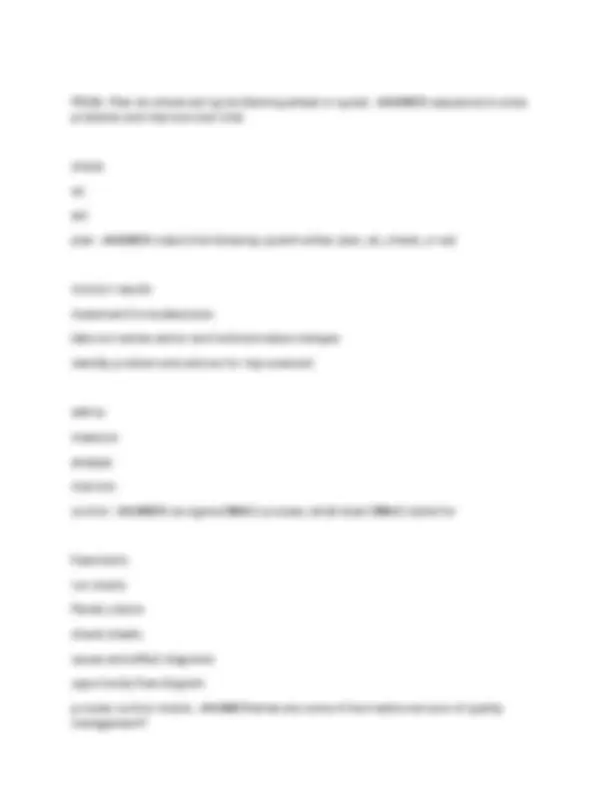
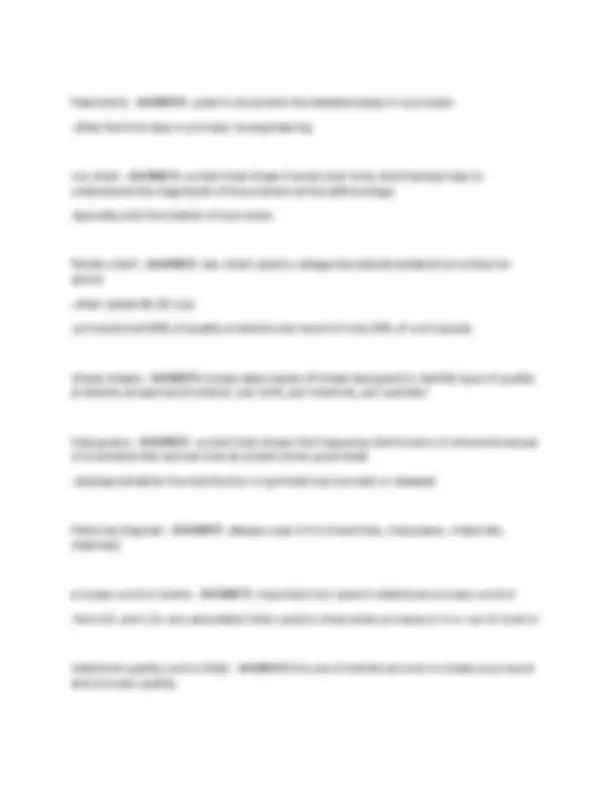


Study with the several resources on Docsity

Earn points by helping other students or get them with a premium plan


Prepare for your exams
Study with the several resources on Docsity

Earn points to download
Earn points by helping other students or get them with a premium plan
Community
Ask the community for help and clear up your study doubts
Discover the best universities in your country according to Docsity users
Free resources
Download our free guides on studying techniques, anxiety management strategies, and thesis advice from Docsity tutors
SCM 186 Exam 2 Questions And Accurate Answers 100% Verified
Typology: Exams
1 / 17

This page cannot be seen from the preview
Don't miss anything!










SCM 186 Exam 2 Questions And Accurate Answers 100% Verified
D - ANSWER A forecast that projects a company's sales is A. an environmental forecast. B. a technological forecast. C. an economic forecast. D. a demand forecast.
C - ANSWER Which of the following statements is NOT true? A. When excess capacity exists, cost can increase. B. When capacity is inadequate, market share can shrink. C. When excess capacity exists, cost can decrease. D. When capacity is inadequate, customers can be lost.
A - ANSWER Which of the following is the FIRST step in a forecasting system? A. Determine the use of the forecast. B. Select the forecast model(s). C. Determine the time horizon of the forecast. D. Select the items to be forecasted.
A - ANSWER Which of the following is a reality each company faces regarding its forecasting system? A. Outside factors that we cannot predict or control often impact the forecast. B. After automating their predictions using computerized forecasting software, firms closely monitor only the product items whose demand is stable. C. Most forecasting techniques assume there is no underlying stability in the system. D. Product family forecast are less accurate than individual product forecasts.
B - ANSWER Which forecast error measure is probably the easiest to interpret? A. MAD B. MAPE C. MD D. MSE
C - ANSWER Which of the following statements is NOT true regarding forecasting? A. Forecasting is the art and science of predicting future events. B. Forecasting may involve taking historical data and projecting them into the future with a mathematical model. C. Forecasting is exclusively an objective prediction. D. A forecast is usually classified by the future time horizon that it covers.
C - ANSWER Which of the following is the FINAL step in a forecasting system? A. Make the forecast. B. Gather the data needed to make the forecast. C. Validate and implement the results. D. Select the forecast model(s).
C - ANSWER Which of the following forecasting steps comes directly after determining the time horizon of the forecast? A. Make the forecast. B. Select the items to be forecasted. C. Select the forecasting model(s). D. Gather the data.
A - ANSWER Which of the following is NOT an external failure cost?
C. control limits are computed using sample standard deviations. D. generally uses control limits set at plus or minus 2 standard deviations of the distribution, rather than plus or minus 3 which is commonly used on the x-bar chart.
A - ANSWER Which of the following statements is NOT true? A. An increased sales effort may help a firm reach its profit goals more easily than would effective cost cutting. B. Supply chain management describes the coordination of all supply chain activities, starting with raw materials, and ending with a satisfied customer. C. The objective of supply chain management is to coordinate activities within the supply chain to maximize the supply chain's competitive advantage and benefits to the ultimate consumer. D. A supply chain includes suppliers; manufacturers and/or service providers; and distributors, wholesalers, and/or retailers who deliver the product and/or service to the final customer.
D - ANSWER Which of the following statements is NOT one of the differentiation strategy decisions? A. Gather and communicate market research data. B. Minimize inventory to avoid product obsolescence. C. Modular design to aid product differentiation. D. Use buffer stocks to ensure speedy supply.
A - ANSWER The advantage of having few suppliers is to A. form a long-term relationship. B. take advantage of diseconomies of scale. C. pursue low cost. D. look for short-term attributes.
B - ANSWER Which of the following mitigation tactics could reduce economic risk?
A. subcontractors on retainer B. purchasing contracts that address price fluctuations C. multiple transportation modes and warehouses D. franchising and licensing
C - ANSWER The do-it-yourselfer plucked a gallon can of base paint from the shelf of the local hardware store and handed it to Keith, the cheerful clerk at the paint counter. Their eyes met briefly and the do-it-yourselfer silently handed over sample 150C-1, Musical Mist, to the clerk. It was impractical to keep several gallons of every possible color on the shelves at the hardware store, so the paint manufacturer had created clever workaround. The workaround was a computer-based system that added predetermined quantities of pigments to a gallon can of base paint depending on the desired shade, in this case, Musical Mist. The hardware store now needed to stock only the base paint, this machine, and a small supply of paint pigments in order to create the thousands of colors in its catalog. This scenario is a prime example of A. drop shipping. B. vendor-managed inventory. C. postponement. D. the bullwhip effect.
C - ANSWER Which of the following is the first stage of supplier selection? A. negotiations B. supplier development C. supplier evaluation D. contracting
A - ANSWER Supply chain managers outsource logistics to meet three goals: A. drive down inventory investment, lower delivery costs, and improve delivery reliability and speed. B. drive down inventory investment, improve delivery reliability and speed, and provide
weighted with a set of exponentially declining weights - ANSWER the difference between a moving-average model and an exponential-smoothing model is that _______
D - ANSWER three popular measures of forecast accuracy are: a. total error, average error, and mean error b. average error, median error, and maximum error c. median error, minimum error, and maximum absolute error d. mean absolute deviation, mean squared error, and mean absolute percent error
D - ANSWER average demand for iPods in the Rome, Italy Apple store is 800 units per month. the May monthly index is 1.25. What is the seasonally adjusted sales forecast for May? a. 640 units b. 798.75. units c. 800 units d. 1,000 units e. cannot be calculated with given info
simple regression has only one independent variable - ANSWER the main difference between simple and multiple regression is _________
D - ANSWER the tracking signal is the: a. standard error of the estimate b. cumulative error c. mean absolute deviation (MAD) d. ratio of the cumulative error to MAD e. mean absolute percent error (MAPE)
C - ANSWER quality is defined as:
a. the degree of excellence at an acceptable price and the control. of variability at an acceptable cost b. how well a product fits patterns of consumer preferences c. the totality of features and characteristics of a product or service that bears on its ability to satisfy stated or implied needs d. being impossible to define, but you know what it is
quality management systems - ANSWER ISO 9000 is an international standard that addresses _______
A - ANSWER If 1 million passengers pass through the Jacksonville Airport with checked baggage, each year, a successful Six Sigma program for baggage handling would result in how many passengers with misplaced luggage? a. 3. b. 6. c. 34 d. 2, e. 6 times the monthly standard deviation of passengers
C - ANSWER the process of identifying other organizations that are best at some. facets of your operations and then modeling your organization after them is known as: a. continuous improvement b. employee empowerment c. benchmarking d. copycatting d. patent infringement
A - ANSWER the Taguchi method includes all except which of the following major concepts? a. employee involvement
A - ANSWER the type of chart used to control the central tendency of variable with continuous dimensions is: a. x bar chart b. R-chart c. p-chart d. c-chart e. none of the above
A - ANSWER if parts in a sample are measured and the mean of the sample measurement is outside the control limits: a. the process is out of control, and the cause should be established b. the process is in control but not capable of producing within the established control limits c. the process is within the established control limits, with only natural causes of variation d. all of the above are true
E - ANSWER control charts for attributes are: a. p-charts b. c-charts c. R-charts d. x bar charts e. both a and b
B - ANSWER the ability of a process to meet design specifications is called: a. Taguchi b. process capability c. capability index d. acceptance sampling
e. average outgoing quality
producer's AQL - ANSWER the _______ risk is the probability that a lot will be rejected despite the quality level exceeding or meeting the ______
build a chain of suppliers that focuses on maximizing value to the ultimate customer - ANSWER the objective of supply chain management is to ____
B - ANSWER the term vertical integration means to: a. develop the ability to produce products that complement or supplement the original product b. produce goods or services previously purchased c. develop the ability to produce the specified good more efficiently d. all of the above
E - ANSWER the bullwhip effect can be aggravated by: a. local optimization b. sales incentives c. quantity discounts d. promotions e. all of the above
C - ANSWER supplier selection requires: a. supplier evaluation and effective third-party logistics b. supplier development and logistics c. negotiations, supplier evaluation, supplier development, and contracts d. an integrated supply chain
quality robustness target-oriented quality quality loss function - ANSWER what are 3 taguchi concepts?
Juran - ANSWER _______ has probably had the greatest impact on the theory and practice of quality management
prevention costs - ANSWER Costs associated with preventing defects and limiting failure and appraisal costs (e.g., training, improvement projects, data gathering, analysis)
appraisal costs - ANSWER Costs associated with inspection to assess quality levels (e.g. staff, tools, training, etc.)
internal failure costs - ANSWER Costs from defects found before delivery to the customer (e.g., rework, scrap, etc.)
external failure costs - ANSWER Costs associated with defects found after delivery to customer (e.g., warranty, recall, etc.)
six sigma - ANSWER quality improvement through elimination of defects and variation
standard deviation - ANSWER statistical measure of variation
3.4 - ANSWER Six Sigma quality is a level of process performance equivalent to producing only ____ defects for every million opportunities or operations
six sigma - ANSWER is a term used to describe process improvement initiatives using sigma-based process measures and/or striving for six-sigma level performance
PDCA; Plan-do-check-act cycle (Deming wheel or cycle) - ANSWER sequence to solve problems and improve over time
check do act plan - ANSWER match the following up with either plan, do, check, or act
monitor results implement formulated plan take corrective action and institutionalize changes identify problem and actions for improvement
define measure analyze improve control - ANSWER six sigma DMAIC process; what does DMAIC stand for
flowcharts run charts Pareto charts check sheets cause-and-effect diagrams opportunity flow diagram process control charts - ANSWER what are some of the traditional tools of quality management?
descriptive statistics statistical process control (SPC) acceptance sampling - ANSWER what are the three categories of statistical quality control?
descriptive statistics - ANSWER describe quality characteristics
statistical process control (SPC) - ANSWER a random sample of output is used to determine if characteristics are acceptable
acceptance sampling - ANSWER sample determines if whole batch is acceptance
strategic sourcing - ANSWER the development and management of supplier relationships to acquire goods and services in a way that aids in achieving the immediate needs of the business
vertically integrate - ANSWER buy the actual supplier
keiretsu - ANSWER have your suppliers become a part of the company coalition
the balanced scorecard - ANSWER measuring performance beyond financial measures
by creating a balanced set of measures linking strategic goals to each of the four critical perspectives
Supply Chain Operations Reference model - ANSWER what does SCOR stand for?
plan, source, make, deliver, return, return - ANSWER what are the steps in the SCOR model
performance features reliability durability serviceability aesthetics perceived quality - ANSWER